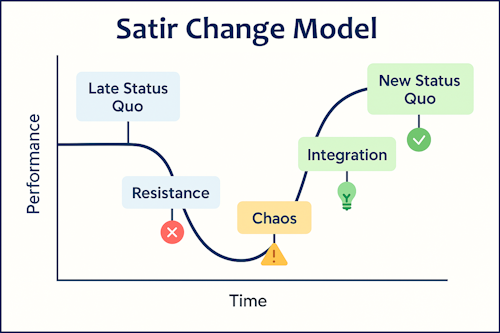Satir Change Model
Adds performance dynamics to team-level transitions.
Late Status Quo → Resistance → Chaos → Integration → New Status Quo

The Satir Change Model offers a powerful lens for understanding how people and systems respond to change, not just logically, but emotionally and behaviorally. Originally rooted in the work of Virginia Satir, a pioneering family therapist in the 1960s and 70s, the model emerged from her observations about how individuals and families react to stress, disruption, and growth. Satir emphasized that change inevitably unsettles our emotional systems, creating turbulence before a new balance can be achieved.
While Satir herself never formalized a five-phase change model, her therapeutic approach laid the groundwork for what later became known as the Satir Change Model. It was Gerald M. Weinberg, a software engineer and systems thinker, who translated Satir's insights into a structured model for organizational and team change in his book Quality Software Management: Volume 4 - Anticipating Change (1997). Weinberg identified five distinct phases: Late Status Quo, Resistance, Chaos, Integration, and New Status Quo - to describe the predictable, emotional arc teams experience when adapting to significant change.
In Agile contexts, where transformation is not only common but ongoing, the Satir Change Model helps Agile coaches and leaders anticipate the natural discomfort of disruption. It also offers strategies to help teams maintain trust, safety, and performance as they move from old habits to new capabilities.
Impact of the Satir Change Model on Organizations
Agile transformations involve shifting from traditional ways of working to more iterative, collaborative, and adaptive approaches. This shift can be disruptive, causing uncertainty and resistance. The Satir Change Model provides a psychological perspective on how teams react to new frameworks like Scrum, Kanban, or SAFe. It helps Agile coaches anticipate challenges and implement strategies to guide teams through transformation smoothly.
Scenario
A company transitioning from a waterfall model to Agile struggles with new roles, workflows, and mindset shifts. Using the Satir Change Model, the Agile coach identifies the following phases:
- Late Status Quo: Teams are accustomed to detailed upfront planning, rigid processes, and hierarchical decision-making.
- Resistance: Employees resist Agile due to fear of uncertainty, perceived job insecurity, or lack of understanding. Stakeholders hesitate to relinquish control.
- Chaos: As Agile ceremonies, iterative planning, and self-organizing teams emerge, confusion and frustration rise. Productivity temporarily drops, and team morale is affected.
- Integration: Teams begin to embrace Agile principles, collaborating more effectively, and realizing the benefits of iterative development and feedback loops.
- New Status Quo: Agile becomes the new norm, and teams achieve higher efficiency, adaptability, and continuous improvement.
Ways to Mitigate Challenges in Each Step:
- Late Status Quo → Resistance
- Educate teams about Agile principles before implementation.
- Address concerns with clear communication and leadership support.
- Create a sense of urgency for change.
- Resistance → Chaos
- Encourage open discussions about fears and uncertainties.
- Provide coaching, training, and mentorship.
- Allow teams to experiment and make mistakes in a safe environment.
- Chaos → Integration
- Reinforce small wins to boost confidence.
- Support teams with Agile coaches and experienced mentors.
- Adapt processes based on feedback rather than rigid adherence to frameworks.
- Integration → New Status Quo
- Foster a culture of continuous improvement and learning.
- Celebrate achievements and recognize efforts.
- Institutionalize Agile values beyond teams into leadership and business processes.
Conclusion:
The Satir Change Model is a valuable framework for understanding and managing the emotional and performance fluctuations during Agile transformation. By recognizing each phase and implementing supportive strategies, Agile coaches and leaders can ease the transition, minimize disruptions, and create an environment where Agile thrives.
Key Takeaways
- Change follows predictable emotional phases: Late Status Quo, Resistance, Chaos, Integration, and New Status Quo.
- Agile transformations often trigger resistance and chaos, but teams can overcome these through coaching, training, and iterative improvements.
- Leaders and Agile coaches must provide psychological safety, clear communication, and a vision for long-term success.
- Small wins, feedback loops, and continuous learning help teams adapt and embrace Agile practices.
Summary
The Satir Change Model explains how teams react emotionally and behaviorally to change, making it a useful tool for Agile transformations. Understanding and mitigating resistance, guiding teams through chaos, and fostering integration ensures a smoother shift to Agile. Agile coaches should proactively support teams at each stage, helping them transition to a high-performing, Agile-driven culture.